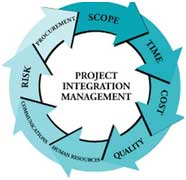Date. 1st January 2024
Project Integration Management is one of the most important aspects of project management. Different organizations adopt different methodologies of project management according to the complexity of the project, and convenience.
Within the same organization, different teams or different departments might work on different methodologies. There are many processes involved to achieve the targeted goal and successful completion of the project. Project integration management ensures to connect all the dots of processes in a structured manner irrespective of the variation in methodologies to successfully complete the project.
Project Integration Management involves a collaborative system between all the elements of project management. For example, if a project is not on schedule, you may need to choose between going over budget or finishing the project late. Assessing the situation and making an informative decision is a key part of project integration management. Integrated project management ensures projects are not managed in isolation. It takes into account how aspects of your project relate to each other but also how other parts of the organization relate to your project. Project integration management is one of the ten key knowledge areas in the Project Management Book of Knowledge PMBOK and is considered a critical success factor for project managers and their work in organizations.
The project integration management has a set of control access points that are undertaken by the Project Manager,here are following.
Initiation Process
The official authorization of the project is handed over during the initiating process group stage. It’s a process where the Project Manager receives the necessary information on how to begin the project. The outputs of the initiation process include creating a project charter, identifying stakeholders and their high-level needs as well as gaining knowledge of the approaches that are necessary for managing those acquired by stakeholders.
Planning Process
Planning is a stage where the Project Manager creates a blueprint for the project which defines the project objectives, milestones, schedules, and initial budget required for the project. It’s considered to be a highly recommended process, as it measures all the knowledge areas of the project and helps in creating a roadmap that in turn will assist in completing the project successfully. All these processes are to be activated into a cohesive whole to prepare a final Project Management plan.
The planning process has a list of activities and they are as follows:
Execution Process
The process of initiating and planning is proven worthy only with proper execution. Execution is a stage where a project manager needs to assure that the project deliverables and objectives meet the stakeholders’ expectations.
Here are some other processes to follow during the executing process stage. These processes belong to several knowledge areas ranging from Project Integration Management to Project Human Resource Management to Project Stakeholder Management.
Monitoring and Controlling Process
This process addresses the skills needed to review progress and document benchmarks in the project. After successful implementation of the first three stages, the project is officially underway. Maintaining a bird’ eye view of the project performance is vital to preserving positive forward momentum.
This process is mainly known for presenting a detailed set of skills and knowledge directly applicable toward implementing the decisions needed to sustain the most active part of the project.
Closing Process
The closing process the last stage in the process of the Project Management Plan. It has equal importance as all the other processes mentioned above. The closing process includes all the final processes required to complete a project and deliver final products and reports to the stakeholders. The critical feature of this stage is to make sure that all contractual obligations have been completely taken care of from the Project Manager’s point of view. Also, where the project manager looks back and carefully observes the undertakings of the project from the beginning to the end. He/she has to make sure that nothing is left un-turned and most importantly everything relating to the project right from small adjustments to more significant changes must be documented and accounted for to leave a lasting and positive impression.
Provides coordination and synchronization throughout the project lifecycle.
The collaborative approach between all stakeholders to ensure the ease flow of project processes throughout the project.
During the transition phase of project processes, project integration plays a vital role in transferring all the inputs required for the next phase of the project.
Integration management is necessary to ensure there is teamwork and all information is synchronized.
Ensures the project execute efficiently
With proper integration management, the project activities are completed without any confusion. After finishing all the tasks, it can be officially closed and resources can be utilized for the next project.
With proper coordination and synchronization projects can run smoothly.
Clear understanding of their roles and responsibilities
With structured integration management, all the stakeholders will be clear about their roles and responsibilities. The planning and coordination between the stakeholders are monitored by the project manager.
Measures and monitors the project’s progress
Integration management ensures the project’s progress information is distributed to all the stakeholders for clear information about the phases and transitions. The necessary steps are taken to bring the firm decisions to meet the objective.
Decisions are made very effectively
The decisions about the key changes required for the smooth project flow is taken by conducting meetings with all the stakeholders. The structured coordination between the stakeholders makes the decisions clearer.

Manages and controls of performances
Project integration management manages and controls the team’s or individual performance, or delay due to the input from other teams or departments.
Ensures due dates, result, project lifecycle, and the benefits management plan are aligned With proper coordination, the project deliverables are delivered on time and according to the plan.


EMBA PGDCM PGDE PGCPM PDBS MQSi SACD
Building Scientist - Construction Economist
Quantity Surveyor - Valuer/ Appraiser
Construction & Project Management
Environmental Science & Natural Resource Management
37 Pattensen Turkeyen, Dennis Street, Georgetown, Guyana
Email: Jewelccameron55@yahoo.com